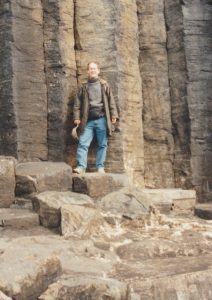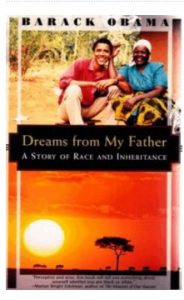For #OldHeadshotDay, me and my dear old black Lab Noah
/0 Comments/in Personal history, Family, Friends /by Philip TurnerGreat to be reminded of my dog Noah, a black Lab who was my companion for many years, from age 15-28; and my cabin in Franconia, New Hampshire. This personal essay tells Noah’s origin story, and some of mine. 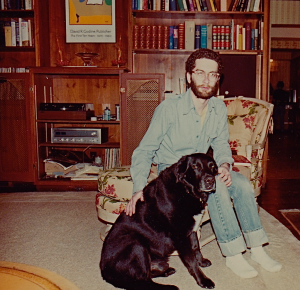
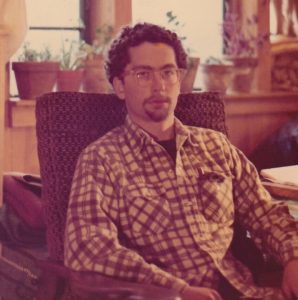
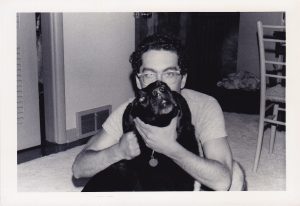
Sexual Harassment at Macmillan Publishing in 1989—A “Me Too” Account
/2 Comments/in Personal history, Family, Friends, Publishing & Bookselling /by Philip TurnerOctober 25 Update: In another day of revelations about sexual harassment, the New York Times‘ Jennifer Schuessler reports that the former literary editor of The New Republic Leon Wieseltier, who was about to launch a new magazine, is stepping down from that position in the wake of his admission that he harassed women at TNR. Publishers Lunch’s coverage (subscription required) of Wieseltier prompted the editors of the book industry website to add a link to my post below about harassment when I worked at Macmillan. Here’s a screenshot of Publishers Lunch’s item next to my original post. 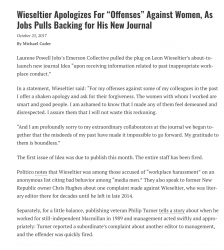
—
Earlier this week, on the day of #WomenBoycottTwitter, I began writing about an episode of sexual harassment that I was close to, then put it aside as it didn’t seem quite apt then. Tonight with the “Me too” theme rapidly spreading on Facebook, now seems the moment:
Appreciating the CBC’s Grant Lawrence for his Evocation of Felix Mendelssohn’s 1829 Visit to Fingal’s Cave
/0 Comments/in Music, Bands & Radio, Nature, Animals, Adventure, Personal history, Family, Friends /by Philip Turner CBC Radio’s Grant Lawrence is for the second consecutive August filling in for three straight weekends as guest host for the Vancouver weekend morning show, “North by Northwest,” which airs from 6am-9am in British Columbia, and a very civil 9am-noon in NYC. I’ve been listening to, and enjoying Grant on the radio since 2009, when he was hosting “Grant Lawrence Live,” a three-hour show most weekday afternoons on CBCRadio 3, the Internet-only outpost for homegrown indie rock n’ roll on Canada’s national broadcasting service. For the devoted audience of which I was a part, we listened to the station as often as workdays, employers, and connectivity would allow. And Grant wasn’t the only popular host—there were many others avidly listened to, and musicians who did guest-hosting. The blend of infectiously enjoyable programming combined the best Canadian indie rock n’ roll; crackling wit, from Grant especially; good heart from all; regular podcasts that supplemented the daily programming; and a lively communal blog on the Radio 3 website where listeners, hosts, and musicians occasionally, were all on line together, sharing thoughts and info on topics-of-the-day, plus current events, both news from the public sphere, and from people’s lives. It made for great radio, a close virtual community, and music, art, and friendship that enriched many lives over several years.
CBC Radio’s Grant Lawrence is for the second consecutive August filling in for three straight weekends as guest host for the Vancouver weekend morning show, “North by Northwest,” which airs from 6am-9am in British Columbia, and a very civil 9am-noon in NYC. I’ve been listening to, and enjoying Grant on the radio since 2009, when he was hosting “Grant Lawrence Live,” a three-hour show most weekday afternoons on CBCRadio 3, the Internet-only outpost for homegrown indie rock n’ roll on Canada’s national broadcasting service. For the devoted audience of which I was a part, we listened to the station as often as workdays, employers, and connectivity would allow. And Grant wasn’t the only popular host—there were many others avidly listened to, and musicians who did guest-hosting. The blend of infectiously enjoyable programming combined the best Canadian indie rock n’ roll; crackling wit, from Grant especially; good heart from all; regular podcasts that supplemented the daily programming; and a lively communal blog on the Radio 3 website where listeners, hosts, and musicians occasionally, were all on line together, sharing thoughts and info on topics-of-the-day, plus current events, both news from the public sphere, and from people’s lives. It made for great radio, a close virtual community, and music, art, and friendship that enriched many lives over several years.
In 2015, the CBC, what’s known in Canada as a “crown corporation”—already under strain for several years due to severe budget cuts under the misrule of Prime Minister Stephen Harper, plus questionable management by CBC appointees who didn’t, and still don’t know broadcasting—ended live daily hosting on Radio 3, with emotional final shows by all the hosts still there, with Grant and another, Lana Gay, among the last remnant. The programming became taped promos, intros, outros, pre-produced musician featurettes, and a livestream of music, much of it by the same artists as before, but lacking the personal touch. The blog was still available to us then, and many of the core still hung out there in virtual space; I continued to visit the blog occasionally, but much less often listened to the live stream. Even though Justin Trudeau came in to office as Canada’s new PM in November 2015, with a promise to restore funding to the CBC, the same management is still in place, and the privation of the service has not noticeably improved yet. Finally, last month even the Radio 3 blog was folded up, too. And, mysteriously, the music content on Radio 3 has been geo-fenced, so it can only be heard within Canada’s borders, even though Radio 3 had long had fans and listeners from the US, Mexico, Britain, Australia, New Zealand, and all over the world.
I’ve drafted a letter that as a lifelong friend of Canada I’ll be sending to the Honourable Mélanie Joly, Minister of Canadian Heritage, who has purview over the CBC. It reads in part,
I am personally and professionally invested in the work of sharing Canadian culture and spreading word of it all among appreciative cultural consumers in New York City, the US, and the wider world, among music lovers, readers, and among people who appreciate what a good country Canada is, with so many creative people.
I am writing to express my sincere hope that you and your colleagues will seriously consider restoring live hosting to CBC Radio 3; the daily live blog; and continue to provide the music service that has introduced myself and many other non-Canadians to the rich treasure house of talented Canadian musical performers.
I very much appreciate your attention to this letter from a non-Canadian. I remain a friend to Canada and to Canadian artists. Thank you for your consideration.
I hope she and her staff will read this and consider reversing course in many areas with regard to CBC Radio. Some of the Radio 3 people have moved on to jobs elsewhere, like Lana Gay who is on-air at Indie 88 in Toronto. For his part, Grant Lawrence has stayed at the CBC, working in social media and digital marketing for CBC Music, the larger entity in to which Radio 3 was folded, then swallowed up and made in to just another of their many live streams.
This is all stated as prologue to explain that I’m pleased when, from to time, Grant does a guest-hosting stint on one of CBC Radio One’s many programs, such as the one mentioned above, on “North by Northwest,” as he has the past two weekends, and coming up again this weekend (August 13-14). On his first weekend in the hosting chair, he aired a fascinating interview with American-Canadian blues legend, Jim Byrnes. He’s also done a segment with Chris Nelson, a First Nations man who acts as custodian of 5,000-year old petroglyphs on the BC coast. Then, last weekend, he broadcast a segment about composer Felix Mendelssohn’s fateful tour of Scotland in early August 1829, when he toured the scenic Hebrides, also known as the Western Isles, located off the mainland of Scotland, 187 years ago this month. Among many majestic sights, the composer visited the isle of Staffa, which is composed of vertical basalt stacks, formed it is said from a volcanic blast that also created the Causeway of the Giants in County Antrim on the northeast coast of Northern Ireland. On Staffa, seven miles distant from the larger island of Mull, Mendelssohn visited Fingal’s Cave, a remarkable setting that inspired him to create new melodies after he experienced its uncannily acute acoustics, with the sea rushing in and out of the sheltered space. Last Sunday, Grant played the splendid orchestral overture “The Hebrides,” and a section from Mendelssohn’s Scottish Symphony.
All this reminded me of a visit Kyle Gallup and I made to Scotland in 1992, when we also toured the Hebrides and visited Fingal’s Cave on a boat ride that landed us at the edge of the island, permitting us to take a brief walk inside the cave, using guiding ropes and metal stanchions sunk in the rock to keep visitors from sliding in to the water. The stanchions looked as if they were fixed in place almost 187 years ago! I’m glad I can share my photos here from our remarkable day, just as Mendelssohn shared his through his music. The first three photos (including the one at the top of this post) show us approaching Fingal’s Cave, the middle two show us after we landed for our brief visit, and the last was taken from inside the cave itself. Thanks to Grant Lawrence for the reason to remember the glorious music of Felix Mendelssohn and our visit to Fingal’s Cave almost 25 years ago! I’ll be listening to him on “North by Northwest” again this weekend, and you can too, right here via the Internet.

What President Obama’s Eight Years Have Meant for Me
/0 Comments/in Personal history, Family, Friends, Philip Turner's Books & Writing /by Philip TurnerNew Book I’m Agenting Points to Breakthroughs in Designing & Building a State-of-the Art Military Helmet
/5 Comments/in Personal history, Family, Friends, Philip Turner Book Productions, Publishing & Bookselling, Technology, Science & Computers /by Philip Turner According to a science article by Washington Post reporter Ben Guarino, the claw of the mantis shrimp packs a wicked punch in dispatching its prey, and has even been known to split or amputate the thumbs of unlucky fishermen. But for me the most remarkable part of this fascinating article regards the material of the claw, or club, as it’s also described in the story:
According to a science article by Washington Post reporter Ben Guarino, the claw of the mantis shrimp packs a wicked punch in dispatching its prey, and has even been known to split or amputate the thumbs of unlucky fishermen. But for me the most remarkable part of this fascinating article regards the material of the claw, or club, as it’s also described in the story:
This startling book, written by two authors who’ve covered the Pentagon for many years, reveals that in the twenty-first century, while traumatic brain injury (TBI) has become the signature injury suffered by our troops, the defense establishment has failed US fighting men and women by continuing to issue them an antiquated military helmet that fails to mitigate the worst of this tragic harm, even though superior design and technology are available.
This investigation by Dina Rasor and Robert Bauman, the first book to examine this most basic item of military equipment, features the stories of two sets of whistleblowers determined to expose the truth about the failures military helmet bureaucracy. Their book braids together the two stories to chronicle the helmet scandal and its human impact.
Readers will learn about retired Navy doctor Robert Meaders, known affectionately as “Doc Bob.” He began helping his grandson obtain protective pads that deterred the blunt force and blast wave impact caused by improvised explosive devices (IEDs). These pads made even the standard issue combat helmet more protective than they were without them. Soon, frustrated by his futile efforts to convince the Marine Corps’ bureaucracy in Washington DC to add these protective pads to the helmets of combat troops in Iraq and Afghanistan, and receiving an avalanche of requests from many Marines for them, he started a nonprofit organization, Operation Helmet, to raise funds so the pads could be provided to the troops free of charge. Despite the improvements his pads offered, Doc Bob was blackballed from the military procurement system
Tammy Elshaug and Jeff Kenner, longtime employees of North Dakota defense contractor Sioux Manufacturing discovered to their dismay that the required density of the Kevlar material woven into netting supplied by Sioux for combat helmets was being shorted in the plant where they worked. Bringing their discovery to the attention of management—believing the boss would surely clean up the illegal practice—they were instead accused of stealing company secrets and having an adulterous affair. Both were fired, leading to a lawsuit and a judgment they won in court that brought the company’s bad faith practices to light.
Doc Bob did not know about Jeff and Tammy and they did not know about him. Yet all three struggled during the same time period to do what was right for the troops. This book chronicles, interwoven to show the courage and dedication of all three, and also, to explain why the Defense Dept, despite news coverage of their revelations, has continued to do the indefensible. The authors use all their years of reporting and investigative experience to explain to readers and policymaker how this could happen. Critically, they also offer information on how the public, press and the military departments can fix the problem and give US troops a better combat helmet that will help them survive their service and continue contributing to the defense of the United States of America.
Upon publication the authors will write op-eds and columns that offer an open challenge to technologists, designers, 3D printers, materials scientists, and high level defense thinkers to finally design the best possible military helmet. Despite the Pentagon’s failure to this point, we also hope to gain their attention to bring new talent and focus to the goal. In the same regard, we are excited about the effort being undertaken by the Head Health Challenge, which also relates to football helmets, an effort that has been covered by Liz Stinson in Wired magazine. I’m hopeful we’ll be able to forge a constructive link between the Defense Dept and the NFL with this initiative to design and build a superior helmet. I recommend you read the marvelous article by Ben Guarino, which also has video from UC Riverside scientist David Kisailus.
#TBT—Remembering Joel C. Turner, All the Way Back to May 1964
/3 Comments/in Personal history, Family, Friends /by Philip Turner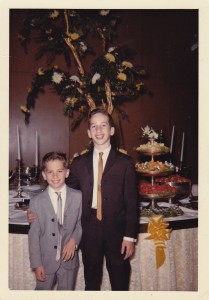 In this old photo I’m getting a hug from my brother Joel at a reception celebrating his Bar Mitzvah, circa May 26, 1964, which would’ve been Joel’s 13th birthday. I’m about 9 here. Looking at the image, I can almost remember the day.
In this old photo I’m getting a hug from my brother Joel at a reception celebrating his Bar Mitzvah, circa May 26, 1964, which would’ve been Joel’s 13th birthday. I’m about 9 here. Looking at the image, I can almost remember the day.
Joel died suddenly in December 2009. A few years later, on what would’ve been his 61st birthday, I posted this remembrance of him here on The Great Gray Bridge.  Obits also ran in the Cleveland Plain Dealer, Publishers Weekly, and Shelf Awareness.
Obits also ran in the Cleveland Plain Dealer, Publishers Weekly, and Shelf Awareness.
Thinking about him, as I do often, because Joel was a gregarious, social person, I know he would’ve enjoyed and thrived amid the advance of social media the past seven years. He had started on Facebook at the time of his death, but none of us, including him, was so aware yet, of how our lives would be influenced by this new media. Joel had early in his adulthood worked as a reporter, and always retained a prodigious appetite for knowing about what was happening in society; he really enjoyed talking with people, asking them questions, hearing what they thought, and offering his views on the matters at hand. He and I didn’t share all the same politics, but the ways we thought about things was were still alike in many ways. He was a kind of social philosopher, and in 2000 ran for Congress on the Libertarian line in a Cleveland-area district. Growing up 3-4 years apart, we encountered many events as a pair in our five-person family—along with our sister Pamela, the eldest + our folks, Earl and Sylvia. We experienced events together, like the JFK and RFK assassinations. I recall be awoken the morning after Bobby Kennedy had been shot, our mom telling us as she woke us that day. The summer of 1970, Joel and I drove from Ohio out to California and spent six weeks camping in a redwood forest. During that trip we adopted our dog Noah. I relate much of that personal history on this Great Gray Bridge webpage. Joel is much missed by all who knew him.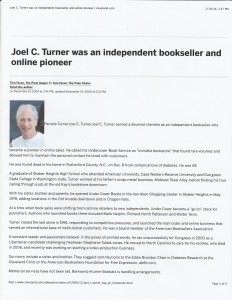
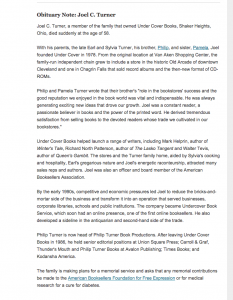
New Year’s Tribute to Mr Stress, Jan 1 1943-May 18 2015, RIP to a Great Bluesman
/2 Comments/in Music, Bands & Radio, Personal history, Family, Friends /by Philip Turner As a New Year’s gift to all my fabulous friends, readers and Internet acquaintances, I’m glad to share memories, an essay, and a few links about Cleveland’s Bill Miller—aka Mr Stress—a great blues harmonica player, singer, and leader of bands who died this past year, on May 18. I followed him avidly from 1972, when I turned 18, old enough to go to bars, to 1985 when I moved to NY. I think of him today, not only because his passing came this year, but because he was the first baby born in Cleveland in 1943, a bare minute after midnight. He was feted on the front page of the next day’s newspaper as the city’s first firstborn—a fitting birth for a bluesman when you consider Muddy Waters singing about the fabled blues character ‘born on the 7th son of a 7th mother on the 7th day.’ Clearly, Mr. Stress had an auspicious pedigree for a bluesman. He would’ve been 73 when the clock & calendar turn tonight. In 2012, I contributed an essay about Stress for the book Rust Belt Chic: The Cleveland Anthology, linked to here. Happily, I reconnected with him after I published the essay. Also, here’s Cleveland Plain Dealer reporter Chuck Yarborough‘s appreciation of him, published two days after his passing; and tributes by Cleveland musician Alex Bevan; and audio of Stress in performance (one and two).
As a New Year’s gift to all my fabulous friends, readers and Internet acquaintances, I’m glad to share memories, an essay, and a few links about Cleveland’s Bill Miller—aka Mr Stress—a great blues harmonica player, singer, and leader of bands who died this past year, on May 18. I followed him avidly from 1972, when I turned 18, old enough to go to bars, to 1985 when I moved to NY. I think of him today, not only because his passing came this year, but because he was the first baby born in Cleveland in 1943, a bare minute after midnight. He was feted on the front page of the next day’s newspaper as the city’s first firstborn—a fitting birth for a bluesman when you consider Muddy Waters singing about the fabled blues character ‘born on the 7th son of a 7th mother on the 7th day.’ Clearly, Mr. Stress had an auspicious pedigree for a bluesman. He would’ve been 73 when the clock & calendar turn tonight. In 2012, I contributed an essay about Stress for the book Rust Belt Chic: The Cleveland Anthology, linked to here. Happily, I reconnected with him after I published the essay. Also, here’s Cleveland Plain Dealer reporter Chuck Yarborough‘s appreciation of him, published two days after his passing; and tributes by Cleveland musician Alex Bevan; and audio of Stress in performance (one and two). 



